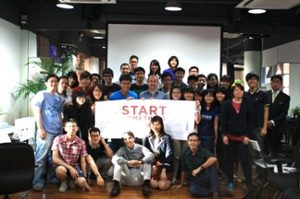
So I was cruising Facebook this weekend and someone posted a note about a new “my first email” app. I have a 6 year-old son, so we gave Maily a try. As a practical service it totally sucks – and I think that’s great. Here’s why.
This is what I said to the folk at Maily:
Hi Guys –
Maily is a great idea and I have a hunch you’re only at alpha with it right now?
Some stuff that came up for my family trying to use it:
1. We thought we could use it with my son’s existing email address, ie as a client with control over messages going in and out from his gmail account and less complexity. Looks like that’s not the case.
2. My wife set it up on her ipad. Downloaded OK but hard to configure. Not clear if we are adding kids or adults at one point in the UI
3. I got an invitation to join after my wife added me as a safe contact. I tried to reply using email on my galaxy S2. The screens don’t display properly on a smaller mobile device – unusable
…
In less than 12 hours this is what I got back:
Hi Hugh,
Thanks a lot for your precious feedback.
As we are bootstrapping we were really targeting to get a minimal viable product, which is clearly the case based on the number of messages sent by kids in the 3 first days (+/- 10 K messages).
Many updates will come in the coming weeks.
Cheers
Raphael
I’ve never met Raphael but if he were here in Singapore I’d give him a big wet kiss.
Why? Because this is exactly what launching a startup should be like. Here are just some of the things these guys have 100% right:
- A good sense of a real-world problem (how do kids start engaging with email safely and easily?)
- Early launch of a prototype (the fact that it hooked me in to try and that they have got 10k others trying it is great evidence that there’s demand for this)
- Prototype is absolutely minimal and barely viable (“If you’re not ashamed of your first launch, you’ve left it too late”). Actually Maily’s prototype is totally viable for what they are trying to do now – to test if they have zoomed in on a real customer problem. They are not trying to test functionality.
- A rapid, positive response has turned me from being faintly disappointed that it didn’t do what I hoped (yet) into a champion.
- An implied commitment to reflect my feedback in future versions. So now I have to stick with them, right? I’m part of what they’re doing.
I blog about this because it feels like JFDI co-founder Meng and I are forever pushing people who come to us for advice on startups out of the door withSteve Blank’s words ringing in their ears: “Get out of the building!”.
The message is to stop thinking, start doing and talk to customers. If you’re looking for startup ‘secret sauce’ – that’s a big dollop right there. Read Derek Sivers and Amir Khella making exactly the same point.
 This is the mantra we shared a couple of weeks ago in a session we ran with MIT for the very first pioneer year of students at the new Singapore University of Technology and Design.
This is the mantra we shared a couple of weeks ago in a session we ran with MIT for the very first pioneer year of students at the new Singapore University of Technology and Design.
The students were great. We met on a Friday night, gave them a briefing then kicked them out onto the streets to talk to customers saying “don’t come back until morning.”
It worked. The students made huge progress during that weekend.
Yet I got this sad note over this weekend:
Many of the teams seem to be stuck in a perpetual planning phase. I think many of them struggle to take the first step in actually building/developing something. If I had to guess at reasons why it would be a mix of the following:
- Don’t have the inspiration and therefore don’t make the time to work on their ideas
- Feel really busy with classes and therefore don’t make the time to work on their ideas
- Lack the confidence that they themselves are actually capable of creating something from nothing
- Are natural planners and obsess over this stage of things
That’s so sad. Where has all the energy gone?
I guess the first two points are killers. I wouldn’t criticize a person for lacking inspiration or being too busy with other stuff, though I probably wouldn’t encourage them to become an entrepreneur.
The second two points are, however, fixable. I am meeting the students again on Friday so I hope to inspire them regarding self-belief.
Strangely, the being “natural planners” issue might be the hardest nut to crack. I blogged at length last week about the way great innovators and entrepreneurs think. Actually much of the time they don’t think. They act.
At school, we’re all taught that clarifying the goal, researching and planning activity, then executing it efficiently, is what gets marks. I wonder if you got the same advice as me about writing essays in exams? It went something like this:
Set out a clear plan at the top of the paper so that the examiner can understand your thinking. Then, even if you run out of time, the examiner can see your intentions and that you fully understood the question.
In other words, covering your arse is the number one priority.
Universities are still giving out this kind of advice. Testing people this way in college is efficient for the college but it does nothing to advance the frontiers of human experience. It’s about regurgitating stuff that’s already been done before. As Meng often says, lab practicals are about repeating an experiment that has been done a million times before with the aim of getting the ‘correct’ result. Same with ‘cases’ at business school. The prize comes for delivering exactlywhat’s gone before.
Entrepreneurship isn’t like that. Repeating what’s already out there is almost guaranteed to fail and no plan ever survives exposure to the real world for more than a couple of days. But the good news in all this is: There Is No Correct Answer.
That’s so important I’ll say it again. There Is No Correct Answer
Sit there trying to find the right answer, deferring action, and you will soon suffer Paralysis by Analysis. It’s a death-sentence for entrepreneurs: the surest way to lose your mojo. But understand that when no-one knows the correct answer there is only feedback – no failure – and you set yourself free.
That’s when being an entrepreneur is worth all the pain and aggravation. And it’s why I applaud Maily for simply giving their idea a go.

